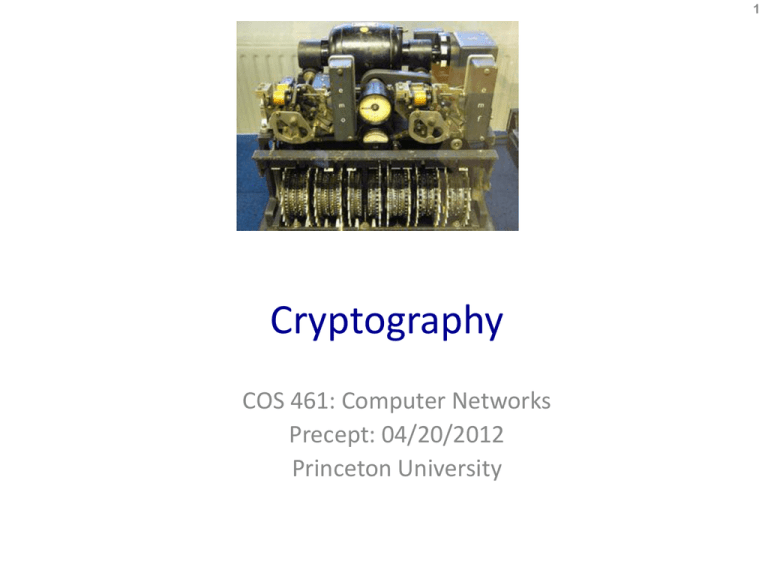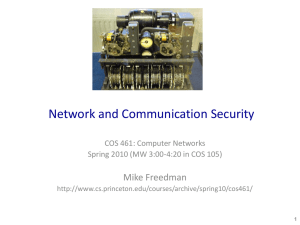Cryptography COS 461: Computer Networks Precept: 04/20/2012 Princeton University
advertisement

1
Cryptography
COS 461: Computer Networks
Precept: 04/20/2012
Princeton University
2
Overview
•
Network security and definitions
•
Brief introduction to cryptography
–
Cryptographic hash functions
–
Symmetric-key crypto
–
Public-key crypto
–
Hybrid crypto
3
Internet’s Design: Insecure
•
Designed for simplicity
•
“On by default” design
•
Readily available zombie machines
•
Attacks look like normal traffic
•
Internet’s federated operation obstructs
cooperation for diagnosis/mitigation
4
Basic Components
• Confidentiality: Concealment of information or resources
• Authenticity: Identification and assurance of origin of info
• Integrity: Trustworthiness of data or resources in terms of
preventing improper and unauthorized changes
• Availability: Ability to use desired info or resource
• Non-repudiation: Offer of evidence that a party indeed is
sender or a receiver of certain information
• Access control: Facilities to determine and enforce who is
allowed access to what resources (host, software, network, …)
5
Eavesdropping - Message Interception
(Attack on Confidentiality)
• Unauthorized access to information
• Packet sniffers and wiretappers (e.g. tcpdump)
• Illicit copying of files and programs
A
B
Eavesdropper
6
Integrity Attack - Tampering
• Stop the flow of the message
• Delay and optionally modify the message
• Release the message again
A
B
Perpetrator
7
Authenticity Attack - Fabrication
• Unauthorized assumption of other’s identity
• Generate and distribute objects under identity
A
B
Masquerader: from A
8
Attack on Availability
• Destroy hardware (cutting fiber) or software
• Modify software in a subtle way
• Corrupt packets in transit
A
B
• Blatant denial of service (DoS):
– Crashing the server
– Overwhelm the server (use up its resource)
9
Impact of Attacks
• Theft of confidential information
• Unauthorized use of
– Network bandwidth
– Computing resource
• Spread of false information
• Disruption of legitimate services
10
Introduction to Cryptography
11
What is Cryptography?
• Comes from Greek word meaning “secret”
– Primitives also can provide integrity, authentication
• Cryptographers invent secret codes to attempt to
hide messages from unauthorized observers
encryption
plaintext
decryption
ciphertext
plaintext
• Modern encryption:
– Algorithm public, key secret and provides security
– May be symmetric (secret) or asymmetric (public)
12
Cryptographic Algorithms: Goal
• Given key, relatively easy to compute
• Without key, hard to compute (invert)
• “Level” of security often based on “length” of key
13
Three Types of Functions
• Cryptographic hash Functions
– Zero keys
• Secret-key functions
– One key
• Public-key functions
– Two keys
14
Cryptographic hash functions
15
Cryptography Hash Functions
• Take message, m, of arbitrary length and
produces a smaller (short) number, h(m)
• Properties
– Easy to compute h(m)
– Pre-image resistance: Hard to find an m, given h(m)
• “One-way function”
– Second pre-image resistance: Hard to find two
values that hash to the same h(m)
• E.g. discover collision: h(m) == h(m’) for m != m’
– Often assumed: output of hash fn’s “looks” random
16
How hard to find collisions?
Birthday Paradox
• Compute probability of different birthdays
• Random sample of n people taken from k=365 days
• Probability of no repetition:
– P = 1 – (1) (1 - 1/365) (1 – 2/365) (1 – 3/365) … (1 – (n-1)/365)
– P ≈ 1 – e-(n(n-1)/2k
– Let k=n, P ≈ 2(N/2)
17
How Many Bits for Hash?
• If m bits, takes 2m/2 to find weak collision
– Still takes 2m to find strong (pre-image) collision
• 64 bits, takes 232 messages to search (easy!)
• Now, MD5 (128 bits) considered too little
• SHA-1 (160 bits) getting old
18
Example use #1: Passwords
• Password hashing
– Can’t store passwords in a file that could be read
• Concerned with insider attacks!
– Must compare typed passwords to stored passwords
• Does hash (typed) == hash (password) ?
– Actually, a “salt” is often used: hash (input || salt)
• Avoids precomputation of all possible hashes in “rainbow
tables” (available for download from file-sharing systems)
19
Example use #2: Self-certifying naming
• File-sharing software (LimeWire, BitTorrent)
– File named by Fname = hash (data)
– Participants verify that hash (downloaded) == Fname
• If check fails, reject data
• Recursively applied…
– BitTorrent file has many chunks
– Control file downloaded from tracker includes:
• \forall chunks, Fchunk name = hash (chunk)
– BitTorrent client verifies each individual chunk
20
Symmetric (Secret) Key Cryptography
21
Symmetric Encryption
• Also: “conventional / private-key / single-key”
– Sender and recipient share a common key
– All classical encryption algorithms are private-key
– Dual use: confidentiality or authentication/integrity
• Encryption vs. msg authentication code (MAC)
• Was only type of encryption prior to invention
of public-key in 1970’s
– Most widely used
– More computationally efficient than “public key”
22
Symmetric Cipher Model
23
Use and Requirements
• Two requirements
– Strong encryption algorithm
– Secret key known only to sender / receiver
• Goal: Given key, generate 1-to-1 mapping to ciphertext that
looks random if key unknown
– Assume algorithm is known (no security by obscurity)
– Implies secure channel to distribute key
24
Distribution of Symmetric Keys
• Options: (between A and B).
– A selects a key and physically delivers it to B.
– If A and B already have have a viable key, it can be used to
distribute a new key.
– A trusted third party key distribution center (KDC) selects a
key and physically delivers it to A and B (through a secure
channel).
25
Distribution of Symmetric Keys
• Manual delivery is challenging…
• The number of keys grows quadratically with the
number of endpoints (n*(n-1)/2)
– Further complexity for application/user level encryption
• Key distribution center (KDC) a good alternative
– Only n master keys required
– KDC generate session key for Alice and Bob
26
Public-Key Cryptography
27
Why Public-Key Cryptography?
• Developed to address two key issues:
– Key distribution: Secure communication w/o having
to trust a key distribution center with your key
– Digital signatures: Verify msg comes intact from
claimed sender (w/o prior establishment)
• Public invention due to Whitfield Diffie &
Martin Hellman in 1976
– Known earlier in classified community
28
Public-Key Cryptography
• Public-key/asymmetric crypto involves use of two keys
– Public-key: Known by anybody, and can be used to encrypt
messages and verify signatures
– Private-key: Known only to recipient, used to decrypt
messages and sign (create) signatures
– Can encrypt messages or verify signatures w/o ability to
decrypt messages or create signatures
29
Public-Key Cryptography
30
Security of Public Key Schemes
• Public-key encryption is a “trap-door” function:
– Easy to compute
c F(m)
– Hard to compute
m F-1(c) without knowing k
– Easy to compute
m F-1(c, k) by knowing k
• Like private key schemes, brute force search possible
– But keys used are too large (e.g., >= 1024bits)
– Hence is slow compared to private key schemes
31
(Simple) RSA Algorithm
• Security due to cost of factoring large numbers
– Factorization takes O(e log n log log n) operations (hard)
– Exponentiation takes O((log n)3) operations (easy)
• To encrypt a message M the sender:
– Obtain public key {e,n}; compute C = Me mod n
• To decrypt the ciphertext C the owner:
– Use private key {d,n}; computes M = Cd mod n
32
Symmetric vs. Asymmetric
• Symmetric Pros and Cons
– Simple and really very fast (order of 1000 to 10000
faster than asymmetric mechanisms)
– Must agree/distribute the key beforehand
• Public Key Pros and Cons
– Easier predistribution for public keys
• Public Key Infrastructure (in textbook)
– Extremely slow
33
Hybrid Encryption
Launch key
for nuclear
missile
“RedHeat”
is...
Symmetric
encryption
(e.g. DES)
User’s public key
(in certificate)
RandomlyGenerated
symmetric
“session” key
RNG
*#$fjda^j
u539!3t
t389E *&\@
5e%32\^kd
Symmetric key
encrypted asymmetrically
(e.g., RSA)
Digital
Envelope
As above, repeated
for other recipients
or recovery agents
Digital
Envelope
Other recipient’s or
agent’s public key
(in certificate)
in recovery policy
34
Hybrid Encryption
Launch key
for nuclear
missile
“RedHeat”
is...
Symmetric
decryption
(e.g. DES)
*#$fjda^j
u539!3t
t389E *&\@
5e%32\^kd
Symmetric
“session” key
Recipient’s private key
Asymmetric
decryption of
“session” key (e.g. RSA)
Digital envelope contains
“session” key encrypted
using recipient’s public key
Digital
Envelope
Session key must be
decrypted using the
recipient’s private key
35
Summary
• Network security and definitions
• Introduction to cryptography
– Cryptographic hash functions
• Zero keys, hard to invert, hard to find collisions
– Symmetric-key crypto
• One key, hard to invert, requires key distribution
– Public-key crypto
• Two keys, hard to invert, more expensive
– Hybrid scheme
• Mon: IPSec, HTTPS, DNS-Sec, other security problems








